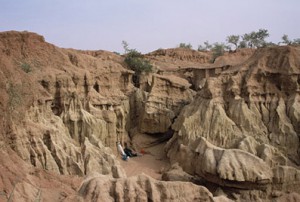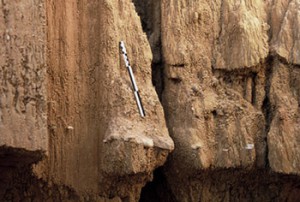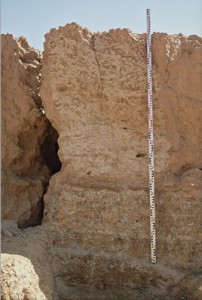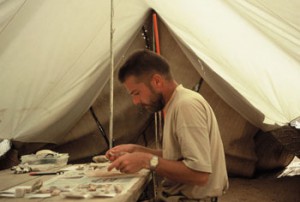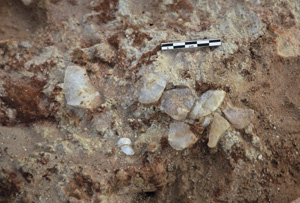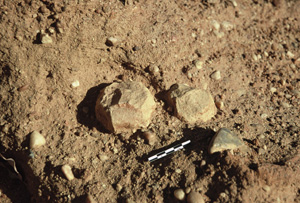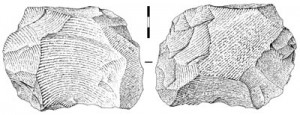West Africa isolated from Palaeolithic research
After a resurgence of activity during the 1980s, West Africa was neglected by Palaeolithic research. The total absence of references to this region in current debates on the conditions for the anthropological and cultural emergence of modern humans, and more largely in syntheses on the Middle Palaeolithic/Middle Stone Age are evidence of this lack of research. This is in part due to the often poor conditions of preservation at Pleistocene sites in these regions, and in particular by the absence of long stratigraphic sequences where questions are increasingly diachronic.
Ounjougou, a rare potential for the West African Palaeolithic
The complex of open-air archaeological sites at Ounjougou offer a rare potential for the study of the West African Palaeolithic: thousands of meters of natural profiles are exposed in the thick Pleistocene sedimentary record in which are interstratified Palaeolithic archaeological layers. The deposits, mostly silty sands, lend themselves well to dating by the OSL method. All of the ingredients were combined to construct a chronostratigraphy and a cultural chronology, which were lacking for West Africa.
It rapidly appeared that most of the deposits could be situated to the end of the Middle Pleistocene and to the Upper Pleistocene, between 200,000 and 20,000 BP, thus encompassing the entirety of the Middle Palaeolithic/Middle Stone Age.
Scientific challenges
While the chronology of the Middle Palaeolithic/Middle Stone Age has been significantly clarified over the past ten years for North, South and East Africa, it remained almost unknown for Sahelian Africa. To establish the chronology was the first step to examine the cultural dynamics and human settlement of these regions. Between the Saharan regions where the Aterian dominated and the forested zones of Central Africa, associated with the Lupembian, what was the cultural identity and settlement dynamic for Sahelian West Africa?
Our objectives
Without fauna or hominid remains, which were not preserved, with only lithic industries but with long stratigraphic sequences, what could research on the West African Palaeolithic intend to do? Our objective was chrono-cultural: to reconstruct the stratigraphic succession of the different Palaeolithic cultural groups in the region by differentiating them by their technological activity, that is, by their lithic industries. The collaboration of a geomorphologist (Michel Rasse) and a geochronologist (Chantal Tribolo) led to the reconstruction of a chronostratigraphy and the placement of Palaeolithic human occupations in an absolute time scale due to dating of the sediments themselves by the OSL method.
Unexpected results
The Ounjougou Middle Palaeolithic is now represented by more than 30 stratigraphically distinct archaeological levels, dated mainly between 80,000 and 20,000 BP, with a particular concentration during OIS 3 (59,000-22,000 BP) in which, as a result of increased sedimentation rates, we reach the mean for an archaeological event identified for 2,500 years. We can thus speak of a high-resolution archaeological and chronological sequence. In addition, this continental sequence clearly records certain abrupt global climatic events during the Upper Pleistocene.
The diversity and frequency of changes in the lithic industries for the Middle Palaeolithic are another characteristic of this sequence at Ounjougou. Apart from being incompatible with the hypothesis of strictly local evolution, it also breaks with the apparent monotony of the Saharan Aterian. Explanation of these changes likely lies with the periodic replacement of populations, for which the cause remains to be determined.
Identity and technological traditions during the Middle Palaeolithic at Ounjougou
The earliest evidence for settlement of the region during the Middle Palaeolithic – a Levallois core with preferential removals – dates to the end of the Middle Pleistocene, between 150,000 and 200,000 BP, but it is only after 80,000 BP that evidence of settlement multiplied. Different industries followed one another until around 22-26,000 BP before ceding to the last intense arid period, which seems to have caused the abandonment of the region by humans.
Despite the poor quality of lithic raw materials, mainly quartz and sandstone, some of these industries present technological and typological characteristics typical of the Middle Palaeolithic: Levallois reduction, discoidal reduction, another kind of centripetal reduction and even successive unipolar reduction. Tools, rare or absent, as is often the case at open-air sites, moreover on such raw materials, include sidescrapers, notches and denticulates.
Several industries are quite comparable to the Middle Paleolithic of Western Europe. Yet the presence of more original industries, almost always unique in the sequence, should be noted. These include an industry with blade production, another with massive rabots and another employing bipolar anvil reduction.
The Seno plain
- Research were extended 15 km southeast of Ounjougou, in the deep sandy accumulations on the Seno Plain which, in contact with the cliff, are deeply incised by erosion. Initial results in this sector tend to confirm the chronostratigraphic sequence at Ounjougou, validating the extra-regional value of pedo-sedimentological data. New industries from the Middle Palaeolithic have been identified, once again increasing the diversity already documented at Ounjougou.

